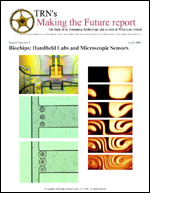
|
|
||||||
|
April/May, 2003 Biochips: Handheld Labs and Microscopic Sensors 43 pages  This
report examines the current state of biochips, organizes key issues
and puts them in context, and succinctly explains how the technology
works. This
report examines the current state of biochips, organizes key issues
and puts them in context, and succinctly explains how the technology
works. Replacing vacuum tubes with computer chips enabled computers to evolve from room-sized machines run by technicians to handheld devices used by ordinary people. Replacing test tubes with tiny channels promises to do the same for biology, chemistry and medicine. The potential rewards including saving a large portion of the hundreds of billions of dollars spent every year on medical testing, drug development and genetics research, speeding tests from hours or days to minutes or seconds, and enabling them to take place in the field. Major research thrusts include using DNA and proteins to sense chemicals, enabling microscopic optics, making tiny channels and devices like valves, and finding ways to mix, pump and manipulate tiny amounts of fluids despite physics making this difficult at such small scales. Though all-purpose handheld biochip devices won't be practical for decades, researchers have begun to build devices that perform specific lab tests in the field. Embedded biochips could eventually power sensors scattered around smart homes, battlefields and toxic waste sites. The report includes an executive summary, a list of 13 developments to look for as these cutting-edge technologies take shape, and a section of 25 researchers to watch, including links to their Web pages. It also includes a quick tour of 41 recent developments and a section of 32 in-depth news stories from TRN. The in-depth news stories are organized into the following categories: DNA-based sensors, other biological sensors, optical sensors, microfluidic channels, microfluidic control, structural manipulators, mechanical manipulators and optical manipulators.
Take a look at all available Making the Future reports. View a four-page sample of the Making the Future report (pdf). |
||||||
|
||||||
|
© Copyright Technology Research News, LLC 2000-2005. All rights reserved. |
||||||
